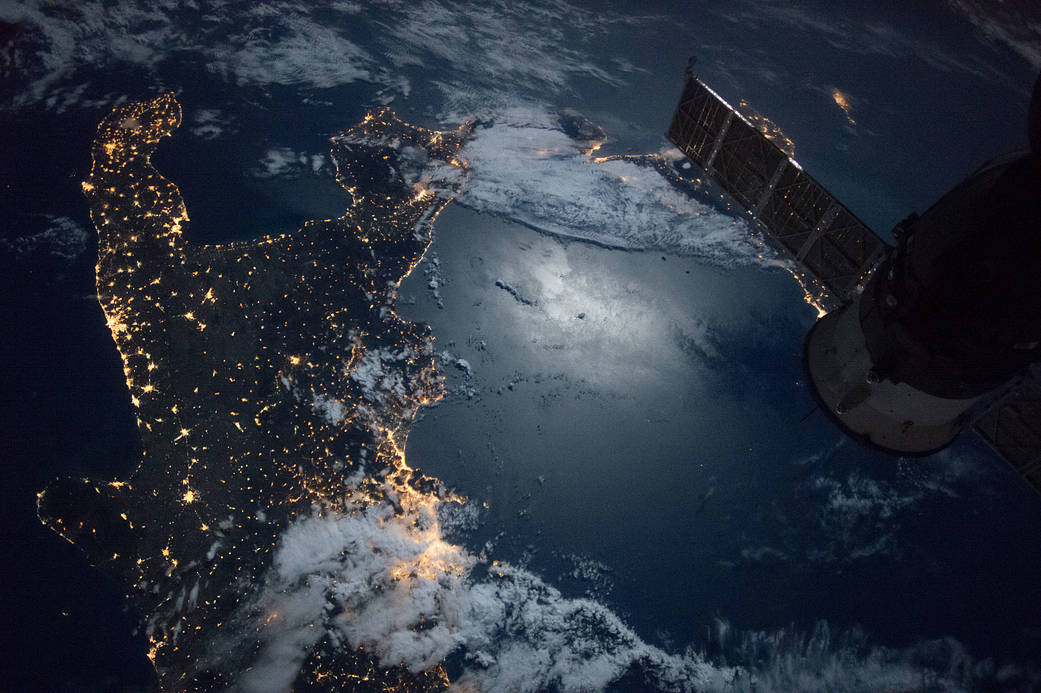オリジナル記事:Infrared Echoes of a Black Hole Eating a Star
This illustration shows a glowing stream of material from a star, disrupted as it was being devoured by a supermassive black hole. The feeding black hole is surrounded by a ring of dust. This dust was previously illuminated by flares of high-energy radiation from the feeding black hole, and is now shown re-radiating some of that energy as heat in the infrared part of the spectrum.
When a star passes within a certain distance of a black hole — close enough to be swallowed up — the stellar material gets stretched and compressed as it is pulled in. A black hole’s destruction of a star, called “stellar tidal disruption,” releases an enormous amount of energy, brightening the surroundings in an event called a flare. In recent years, a few dozen such flares have been discovered, but they are not well understood.
Astronomers gained new insights into tidal disruption flares thanks to data from NASA’s Wide-field Infrared Survey Explorer (WISE). Studies using WISE data characterized tidal disruption flares by studying how surrounding dust absorbs and re-emits their light, like echoes. This approach allowed scientists to measure the energy of flares from stellar tidal disruption events more precisely than ever before.
JPL manages and operates WISE for NASA’s Science Mission Directorate in Washington. The spacecraft was put into hibernation mode in 2011, after it scanned the entire sky twice, thereby completing its main objectives. In September 2013, WISE was reactivated, renamed NEOWISE and assigned a new mission to assist NASA’s efforts to identify potentially hazardous near-Earth objects.
Image credit: NASA/JPL-Caltech
Last Updated: Sept. 16, 2016
Editor: Tony Greicius
ブラックホールが星を食べるところの赤外線写真
このイラストは、超巨大なブラックホールによって捕まった星が、粉々の物質に砕かれて捕食される恐ろしい流れを表現しています。星を食べているブラックホールは塵のリングに囲まれています。この塵は、ブラックホールから放射される高エネルギーのフレアによって照らされており、そして今スペクトル分布における赤外線部分で、熱エネルギーとしてを再放射しているところが示されています。
星がブラックホールの一定距離内(飲み込まれるのに十分近い距離)を通過すると、星の物質が引き伸ばされ、そして引きずり込まれ押しつぶされます。ブラックホールによる星の破壊を「星の潮汐破壊」と呼び、フレアと呼ばれる現象で周囲を明るく照らし出し、膨大なエネルギーを放出します。近年では、数十のフレアが発見されていますが、十分には解明されていません。
天文学者はNASAの広域赤外線探査衛星(WISE)のデータにより、潮汐破壊のフレアの新らたな分析をしました。 WISEのデータを用いた研究は、周囲の塵がエコーのように、光を吸収し再放出することに着目し、潮汐破壊フレアを分析します。このアプローチで、科学者はより正確に星の潮汐破壊現象のフレアのエネルギーを測定することができました。
JPLは、ワシントンのNASAの科学ミッション本部のためのWISEを運営しています。WISEは、2回にわたり全天空をスキャンし、その主な目的を完了した後、2011年に休止状態に置かれました。 2013年9月に、WISEはNEOWISEと名前を変更し、地球近傍に潜む危険な物体を識別するためのNASAの取り組みを支援するため、新たな任務を割り当て、再起動されました。
訳者注
ブラックホールが星を捕食するさまは2015年にも取り上げられ、動画も公開されています。
Destroyed Star Rains Onto Black Hole, Winds Blow It Back

動画はこちら











